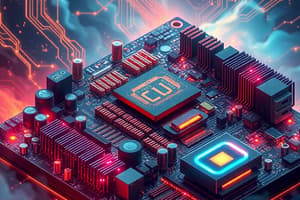Podcast
Questions and Answers
The CPU socket is where the RAM is installed.
The CPU socket is where the RAM is installed.
False (B)
What is the primary function of the CPU in a computer system?
What is the primary function of the CPU in a computer system?
- Fetching, decoding, and executing program instructions (correct)
- Providing power to components
- Managing network connections
- Storing data for long-term use
What differentiates the physical layout of newer RAM slots from older ones?
What differentiates the physical layout of newer RAM slots from older ones?
- They have identical gap placements
- All RAM modules are of the same length
- Same number of pins in all modules
- Some have more pins and different slot shapes (correct)
Name two types of CPU socket configurations discussed.
Name two types of CPU socket configurations discussed.
SDRAM requires a voltage of ___ volts to function.
SDRAM requires a voltage of ___ volts to function.
Match the RAM types with their specifications:
Match the RAM types with their specifications:
LGA sockets feature pins on the processor itself.
LGA sockets feature pins on the processor itself.
What is the role of the CMOS battery on the motherboard?
What is the role of the CMOS battery on the motherboard?
Which type of RAM has a maximum capacity of 1GB?
Which type of RAM has a maximum capacity of 1GB?
DDR4 can have a capacity of up to 32GB.
DDR4 can have a capacity of up to 32GB.
What does BIOS stand for?
What does BIOS stand for?
What does PCI stand for?
What does PCI stand for?
The CMOS battery is responsible for maintaining __________ in the motherboard when the computer is powered off.
The CMOS battery is responsible for maintaining __________ in the motherboard when the computer is powered off.
PCI Express offers lower performance compared to its predecessor AGP.
PCI Express offers lower performance compared to its predecessor AGP.
What is the primary function of expansion buses?
What is the primary function of expansion buses?
What are the two main chipsets in a computer?
What are the two main chipsets in a computer?
Match the RAM type with its specifications:
Match the RAM type with its specifications:
The primary role of the __________ is to control transfers between the processor and RAM.
The primary role of the __________ is to control transfers between the processor and RAM.
What technology has largely replaced IDE in modern motherboards?
What technology has largely replaced IDE in modern motherboards?
The PCI slot was first introduced with the Intel Pentium processor in 1993.
The PCI slot was first introduced with the Intel Pentium processor in 1993.
Name one socket type that supports DDR3.
Name one socket type that supports DDR3.
The SouthBridge connects faster peripheral devices like RAM and the processor.
The SouthBridge connects faster peripheral devices like RAM and the processor.
Match the following terms with their correct descriptions:
Match the following terms with their correct descriptions:
What is the function of the BIOS in a computer system?
What is the function of the BIOS in a computer system?
Flashcards are hidden until you start studying
Study Notes
CPU Socket
- The CPU (Central Processing Unit) serves as the brain of the computer, responsible for executing program instructions and performing calculations.
- CPU socket types include LGA (Land Grid Array) with pins on the socket and PGA (Pin Grid Array) with pins on the CPU.
Memory Slot
- RAM slots allow for the insertion of RAM modules, with high-tier motherboards supporting multiple slots.
- Variations in RAM modules include differences in pins, gaps, keyway slots, height, and length due to evolving technology.
- Types of RAM include:
- SDRAM: 64-bit bus, 168 pins, requires 3.3V.
- DDR1: 184 pins, maximum capacity 1GB; compatible with various sockets.
- DDR2: 240 pins, max capacity of 4GB, replaced DDR1 in 2005.
- DDR3: Similar shape to DDR2, 240 pins, max capacity of 8GB; supported by LGA and AMD sockets.
- DDR4: 288 pins, up to 16GB capacity; high-end and compatible with specific Intel and AMD sockets.
BIOS Chip & CMOS Battery
- BIOS (Basic Input/Output System) stores motherboard information and settings; acts as a link between hardware and software during startup.
- BIOS resides on a ROM chip, retaining data without power.
- CMOS battery maintains BIOS settings when the computer is powered off, prevent data loss, and is removable for resetting.
Expansion Buses
- Expansion buses enable the addition of expansion cards (e.g., graphics cards, sound cards) to the computer.
- PCI (Peripheral Component Interconnect) is a common expansion bus standard, designed for connecting peripheral devices.
- Other types of buses include ISA and EISA.
PCI Slots
- PCI slots accept devices requiring power; originated with Intel Pentiums in 1993.
PCIe Slots
- PCI Express (PCIe) superseded AGP as the mainstream connection due to enhanced transfer speeds and bandwidth, becoming standard for graphics card connections.
IDE or SATA Slot
- IDE (Integrated Drive Electronics) is an older interface, whereas newer motherboards utilize SATA (Serial ATA) technology for connecting storage devices, providing improved speed and efficiency.
The Computer Chipsets
- NorthBridge (Memory Controller): Controls data transfers between the processor and RAM, located near the CPU.
- SouthBridge (Input/Output Controller): Manages communications with peripheral devices, including USB and audio. Known as I/O Controller Hub (ICH).
Studying That Suits You
Use AI to generate personalized quizzes and flashcards to suit your learning preferences.




